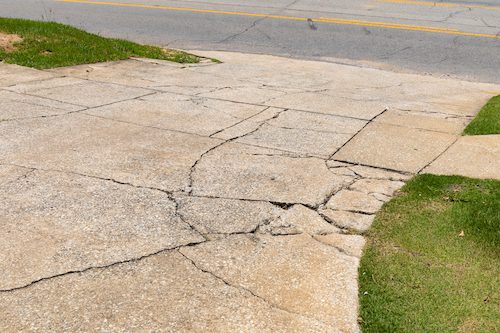When you have a cracked driveway or broken walkway, it can be difficult to decide whether concrete repair or concrete replacement is the best long-term solution. Repair may seem too temporary, but replacement can get very expensive!
If you’re unsure whether repair or replacement is the right choice for your concrete, here’s how to decide — and why we believe polyjacking should be your solution!
Choosing the Right Method of Concrete Repair
Concrete repair is a pretty broad category, as several methods of concrete repair are available. If you’re planning to simply caulk the cracks or follow another DIY concrete repair method, then it’s true that concrete replacement will be better in the long run. However, there are more long-lasting methods of concrete repair that are much more affordable than replacing entire slabs!
As you consider how to solve your concrete problems, you need to first understand what is causing your concrete to crack and become uneven. Concrete typically sinks and breaks because of shifts happening under the surface. The ground supporting your concrete could erode with time, or your original cement may have been poured on unstable soils.
If your concrete problems result from issues beneath the surface, no amount of DIY filling or sealing above will solve the instability below! What you need is a method of repair that focuses on concrete leveling.
The two contenders for concrete leveling are polyjacking and mudjacking. Mudjacking is the traditional method and cheaper, but it doesn’t last forever and requires a good amount of maintenance to keep your concrete from sinking under the heavy mixture injected beneath it. For this reason, we believe the best way to fix your concrete is with the concrete repair method known as polyjacking!
Why Polyjacking is Better than Concrete Replacement
Polyjacking uses the same concept as mudjacking—filling the voids beneath your concrete and pushing slabs up to level once more—but with a much less invasive and more permanent process. This fast and almost instantaneous method of concrete repair involves injecting a lightweight polyurethane foam into the problem areas. This foam flows like a liquid into every nook and cranny before expanding to lift your concrete and hardening to lock it in place.
Unless your concrete is completely shattered and unsalvageable, polyjacking will always be your best option! Compared to concrete replacement, polyjacking:
- Is more affordable
- Is more eco-friendly
- Produces less waste
- Stabilizes soils
- Is non-invasive
- And takes very little time.
Still not sure if concrete repair with polyjacking is the best solution for your concrete? Read on to see what we would recommend in common concrete considerations.
Repair vs. Replacement for Old Concrete
Is the concrete you’re looking into fixing up very old? Most concrete lasts from 50 to 100 years, so unless you live in a very old neighborhood you’re unlikely to have reached that point. Here is the average lifespan of different types of concrete:
- Concrete foundations for buildings: 100-200 years
- Concrete sidewalks: 25-30 years
- Concrete driveways: 25-30 years
- Polished concrete floors: 20-50 years
If your concrete is showing signs of wear and aging, it may be time for replacement. However, even old concrete can have its lifespan extended with a little fortification! By polyjacking your old concrete, you could add another decade or more to its lifetime.
Restoring Concrete Appearance
Have you ever noticed the very dark and aged-looking concrete in older, historic towns? If your concrete is looking similar, it may just need a fresh cleaning and sealing to keep it from darkening anymore with age. Because polyjacking focuses on solving underlying concrete issues, it won’t change the coloring of your concrete. It will restore it to a beautiful, level appearance, but if you want it to look completely brand new then you may need to consider resurfacing or replacing.
Repair vs. Replacement for Concrete Foundations
Replacing an entire concrete foundation is not only expensive, it’s also very complicated and invasive! Before a new concrete foundation can be poured under an existing residential home, for instance, the entire house has to be lifted and either moved or raised high enough for the concrete replacement crew to access the full area beneath. The old foundation will also need to be broken up and removed to make room for the new concrete to pour.
The process of jacking up a house and replacing the foundation usually takes three to four months, during which time you will not be able to live in the home! By contrast, most concrete repair only takes three or four days at most. Polyjacking can be completed in as little as a few short hours!
When In Doubt, Polyjack!
If you’re not sure what the right method is to fix your concrete problems, give polyjacking a try! It’s fast, affordable, and you’ll be amazed at how quickly it makes your concrete look brand new again. Foundations, sidewalks, driveways, and even farm silos—Pro Polyjacking can handle whatever your concrete throws our way. Contact us for a free inspection and estimate!
